The Pedalboard...
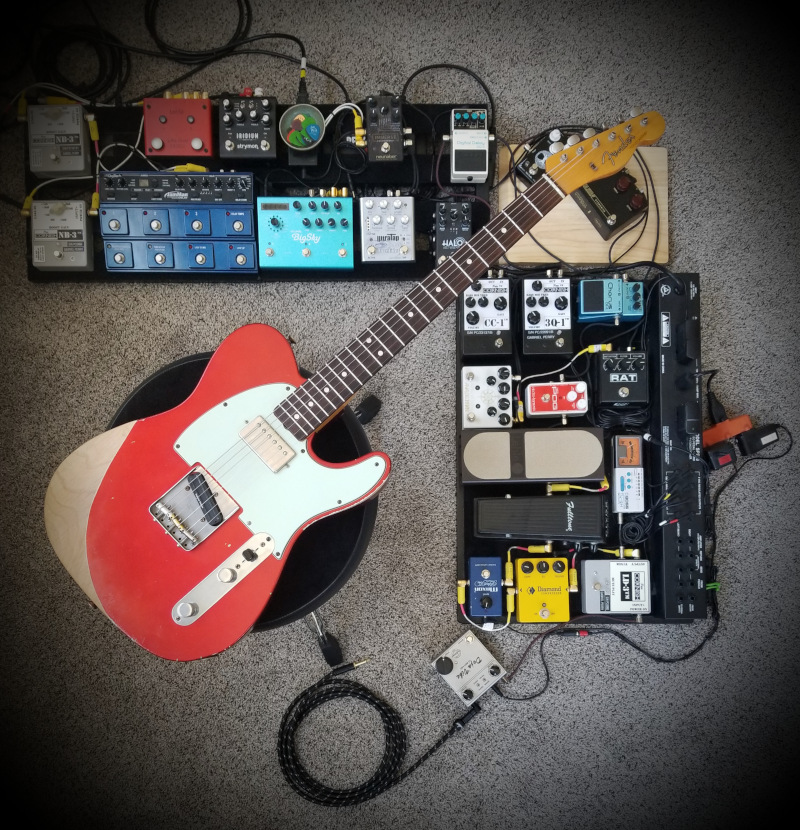
The board shown here is the result of many years of experimentation, much trial and error. I didn't start out to build such a monster, but things evolved and grew over time. As many of you know who own pedalboards, it's a process or a disorder depending on how you choose to look at it. Over the last few years, however, things have really settled down and stabilized. This setup has become my main studio/recording board. It never leaves the house, for obvious reasons.
Six Signal Stages
- ↑ Back to TopThe board may look overly complicated and/or intimidating, but it's actually fairly straight forward and simple to use once you understand the different stages the guitar signal flows through. In my mind there are six (6) stages: 5 stages or groupings of pedals and a final stage, amplification.
- Stage 1: Dynamic and volume related effects. Also, "old-school" modulation effects (Uni-Vibe, and phaser).
- Stage 2: The Gain Stages: Numerous distortion/overdrive pedals with an EQ at the end of this stage used for tone shaping (EQ-ing) and as a master volume.
- Stage 3: Consists of two (2) pedals: An octave effects unit and a stereo chorus pedal which splits the guitar signal into a stereo signal.
- Stage 4: Numerous stereo delay/reverb pedals. Also contains a stereo Delay/Looper pedal.
- Stage 5: Stereo Clean boosts, amp switching/routing.
- Stage 6: Amplification: a Carr Rambler and a Mojave Plexi 45. The pedalboard stereo signal can also be routed to an "amp in a box" pedal if I want to bypass my amps. In my case, I'm using the Strymon Iridium for this purpose.
An Aside: Compared to other boards, which use advanced switching systems, my board is a bit "old school" in the sense that I plug each pedal into the next, serially, one after the other. I'm not using a MIDI controller or any kind of programmable effects-switching device like a G2/3 GigRig or a Voodoo Lab Pedal Switcher. However much I may be intrigued by the newer switching and routing technologies I simply do not have a real compelling need to justify such a system. Maybe someday, but not today.
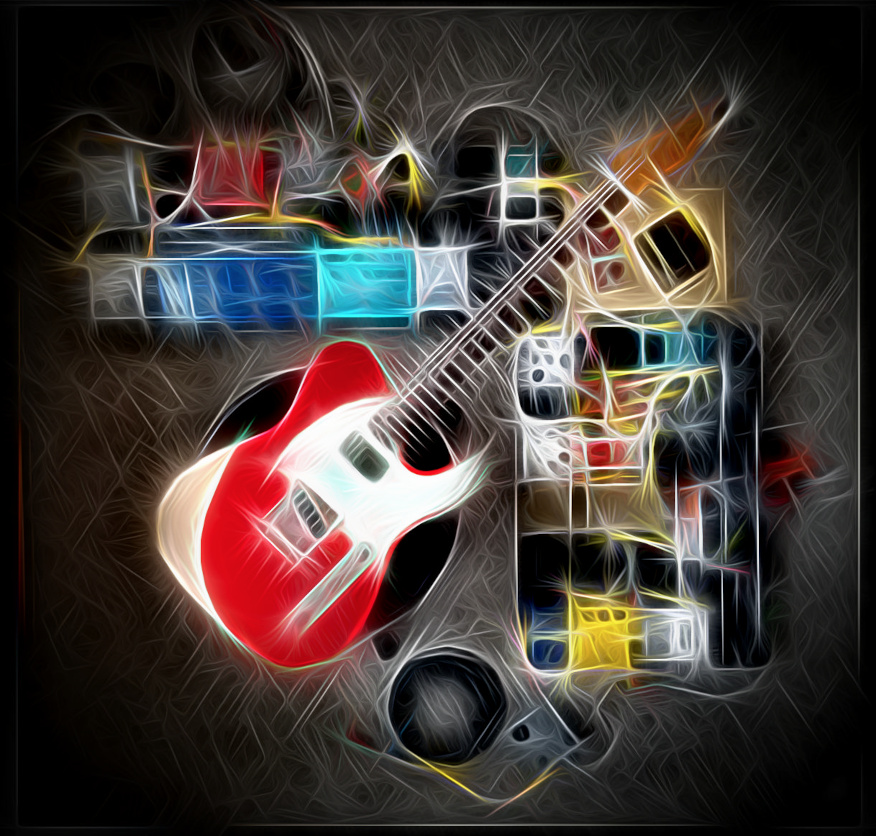
Signal Chain: An Overview
- ↑ Back to TopLet's talk signal chain from a high level. I'll go into greater detail later about what each pedal does and its purpose on the board below.
- The Deja Vibe is the first pedal in the signal chain. It comes before any other pedal; my guitar plugs straight into it. The signal then travels to the Pete Cornish LD-2 Line Driver (preamp) pedal. It then hits a compressor, a Maxon phaser, a Fulltone Wah, and then a Lehle volume pedal. You can think of this first group of pedals as the "first stage" of the signal chain which relates to playing dynamics and volume. I want my pickups as close as possible to these pedals.
-
The second signal stage contains multiple distortion and overdrive
pedals. You can think of each gain pedal as an "amplifier channel"
or its own gain stage. This second signal stage also consists of a
"guest loop" which can accommodate two pedals. This is a great way
to demo or try other pedals without having to fuss with the main
cabling for the main distortion/overdrive pedals. Currently, in the
guest slot are a Mythos Mjolnir overdrive pedal which is a Klon
clone and a Vick Audio Tree of Life Overdrive pedal. Sometimes a
JHS PackRat resides there, or a Muff variant. You get the idea.
After the guest-loop we go into the three main distortion and overdrive pedals that never leave the board: an American-made Proco RAT 2 pedal, an AnalogMan King of Tone, and a Pete Cornish CC-1 Overdrive. The signal then travels to a Pete Cornish 3Q-1 (EQ) pedal or sometimes a Cornish ST-2 (Tone Boost). I use them interchangeably and each can function as a master volume in addition to providing tone shaping capabilities.
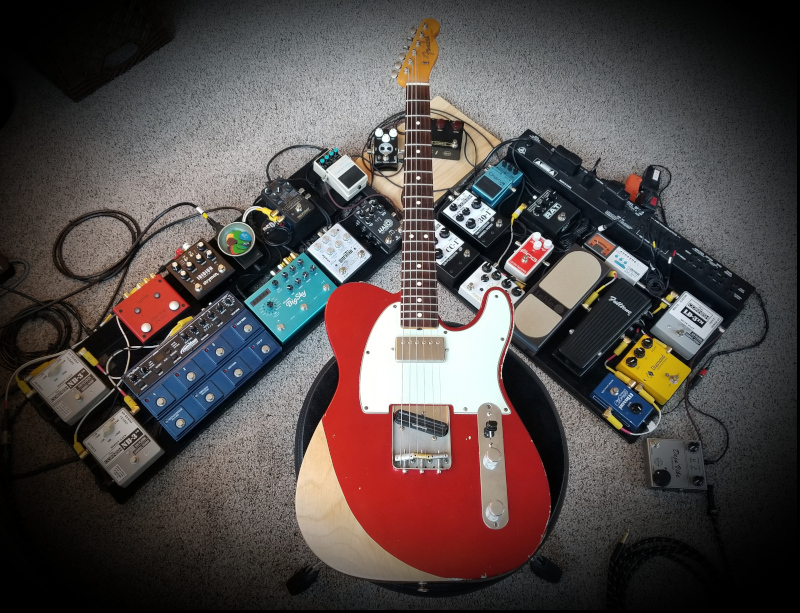
- From here we enter the 3rd stage, an octave up/down and/or modulation stage. This stage consists of two pedals: an Electro-Harmonix POG and a BOSS CE-3 Chorus pedal. I think both of these pedals sound great after my overdrive pedals as opposed to before. I think think they sound best here.
- Stage 4 is consists of a series of delays and reverbs.
-
Finally, we enter the last stage before amplification, Stage 5. This
stage consists of two Pete Cornish NB-3 (clean boost) pedals, one
for each stereo channel (amp). The boosts route into the last pedal
in the signal chain, a Lehle amp switcher/router. This pedal helps
resolve the grounding problems (hum) associated with playing through
two amps at the same time. If you want to play stereo, into two
different amplifiers, you need a pedal like this to make sure your
guitar signal is properly grounded.
The two clean boosts at the end provide two functions. The first being a way for me to change the volume going to each amp. This helps me balance the stereo effect. The second function is to serve as a line buffer ensuring my guitar signal is strong enough before going into each amp.
Remember, the buffer is active whether the pedal is engaged or not. It is not true-bypass and this is by design. I want high quality buffers at the end of the pedalboard and Cornish delivers this functionality beautifully. - The Lehle plugs into two separate amplifiers, a Carr Rambler, and a Mojave Plexi 45 both of which are equipped with 6L6 power tubes for plenty of clean headroom. Also, the Lehle can plug into an "amp in a box" pedal, in my case a Styrmon Iridium pedal which I feed into an interface for recording. It can also feed into a PA system for amp-less gigging.
High Quality Buffers: The Secret Weapon
- ↑ Back to TopThe key or "secret weapon" to this pedalboard are the four Pete Cornish pedals strategically placed throughout the signal chain. Each pedal contains an exceptionally high-end buffer. A good buffer makes your guitar tone sound "natural" with good playing dynamics. In short, it preserves the strength of the signal running through a pedalboard.
The LD-3, a line driver/preamp pedal, is the first pedal of this type. It boosts my guitar signal and also provides some RFI filtering which is essential considering how dirty power sources can be or how lights or other electromagnetic sources can interfere with one's guitar pickups, etc.
I also make use of an ST-2 Tone Boost which acts mainly as an EQ pedal and is placed just after my overdrive/distortion pedals. Here are some sample ST-2 settings. NOTE: I sometimes interchange the ST-2 for a Cornish 3Q-1 pedal instead. Both of these pedals, however, serve essentially the same function on my board.
As stated previously, I run the stereo signal through two NB-3 Clean Boost pedals. Cornish does not believe in true-bypass and instead uses very high quality buffers and other electronic technology to massage and control the guitar signal.
My logic works like this: Because I have so many pedals on the board I employ 4 buffers in the signal chain to ensure the signal is strong enough by the time the signal hits the amps: one up front (the LD-3), one after the gain pedals (the 3Q-1 or the ST-2), and finally two NB-3s at the end (one for each channel) before hitting the amps.
The board sounds extraordinarily clean with a deeply rich tone. I couldn't be happier with it and I know I'm extremely lucky to own such a powerful tone shaping tool. I would feel lost without it!
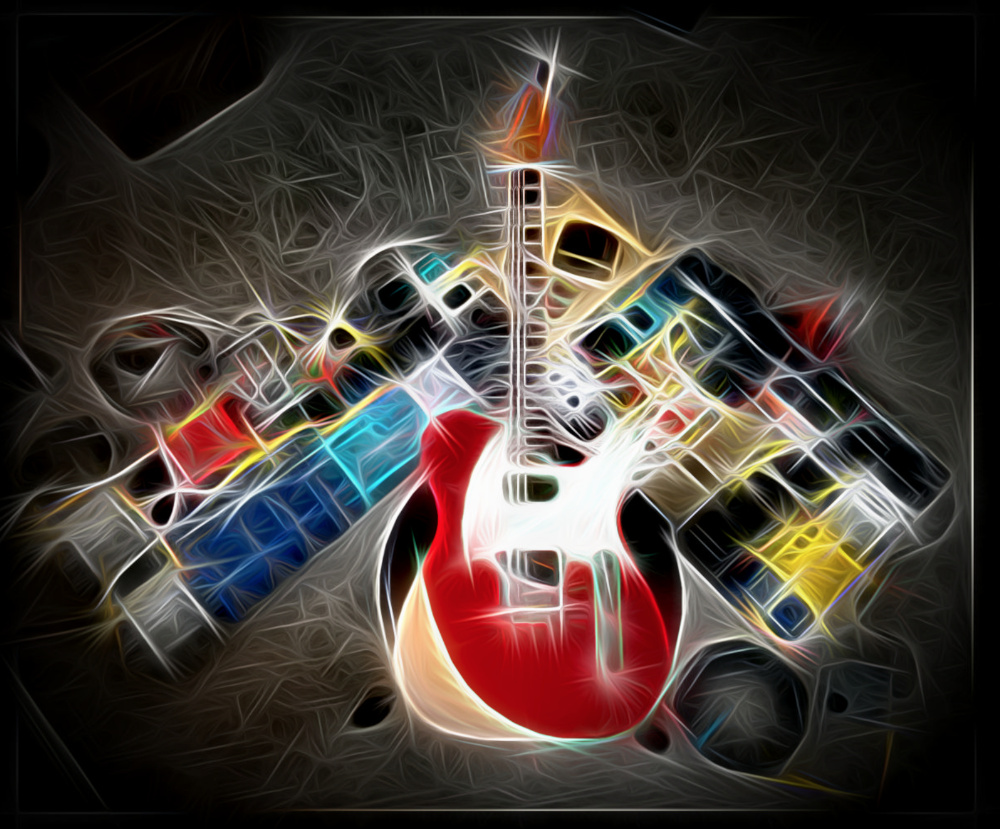
Pedal Details
- ↑ Back to Top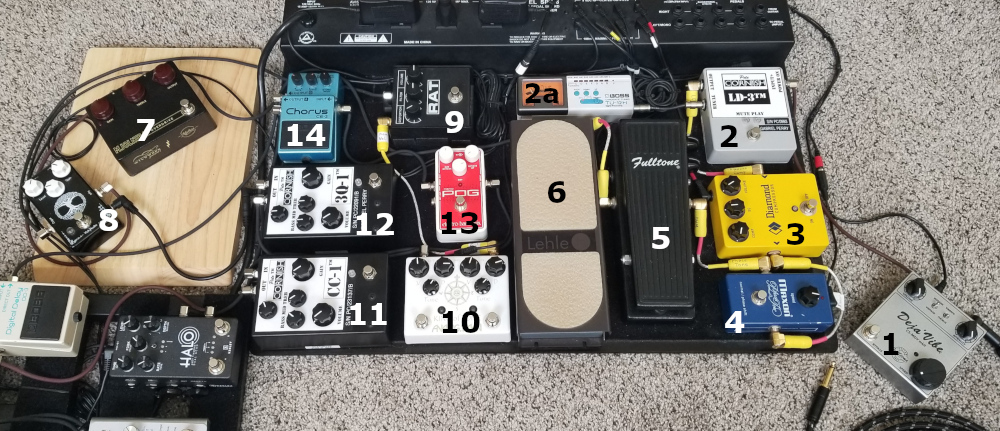
| Pedal Order | Pedal Description |
|---|---|
| 1. |
Fulltone Deja Vibe CS-MDV mkii: A wonderful UniVibe clone made by Fulltone. What's cool about this pedal is that one can turn the Volume level up and it will act as a Boost! This is exactly what I do to give an overdrive a little extra oomph! << Back to Pedalboard Image |
| 2. |
Pete Cornish LD-3: Line Driver (Pre-amp) with Mute switch and dedicated Tuner out which feeds into my BOSS TU-12H tuner. << Back to Pedalboard Image |
| 2a. |
BOSS TU-12H Tuner: A chromatic tuner. << Back to Pedalboard Image |
| 3. |
Diamond Compressor: This is a wonderful and natural sounding compression pedal. It's also a sort of 'set and forget' kind of pedal for me these days which means it's almost always on when I'm playing and I rarely mess with it. << Back to Pedalboard Image Here's the user manual for the Diamond Compressor. |
| 4. |
Maxon PT-999 Phase Tone: A phaser pedal. NOTE: I've got this pedal situated on the board such that I can adjust the speed knob with my foot while I'm playing. These are important considerations when setting up such a board. It needs to be playable. Also, I like having my phaser pedal before my gain pedals as opposed to afterwards. This makes the phasing sound less affected and more mellow which I like very much, but I know some players put their phaser after their distortion/overdrive pedals. << Back to Pedalboard Image |
| 5. |
Fulltone Clyde Deluxe Wah: A Wah Wah pedal. << Back to Pedalboard Image |
| 6. |
Lehle Mono Volume Pedal << Back to Pedalboard Image |
| 7. |
Mythos Wildwood Mjolnir Overdrive Pedal: A sweet-ass replica of a certain "Klon Centaur" overdrive. << Back to Pedalboard Image |
| 8. |
Vick Audio Tree of Life Overdrive Pedal: An excellent Blues Breaker circuit. This puppy sounds a lot like my AnalogMan King of Tone pedal. It can do everything the left side of the KoT can do, but it doesn't have quite the max amount of gain as the right side. But, it's a great pedal, indeed. << Back to Pedalboard Image |
| 9. |
ProCo RAT Distortion Pedal: A stock (no mods) RAT distortion pedal circa 1990. Made in the U.S.A. This one has a RED LED light/indicator unlike its predecessor. I use this pedal for my main high gain lead tones but it also sounds great when the gain is set to 9 o'clock, the filter and volume both set at 3 o'clock. << Back to Pedalboard Image NOTE: There is never any need to modify this pedal. I should know because I've mod'd a few. It's simply a wonderful dirt box and I can get some really sweet high gain tones out of it. Also, it's better to get a U.S.A. made one versus the newer Chinese versions which tend to sound more brittle somehow. Maybe it's just a psychological thing, but I like the ones made in the USA better. REMEMBER: Don't mod the American made versions. They sound great as they are. Another viable option is the PackRat by JHS. It sounds just as good as the American made RAT 2. It actually has 9 RAT circuits built into and they all sound cool. |
| 10. |
AnalogMan "King of Tone" Distortion/Overdrive Pedal - Version 4: This is a killer dual distortion/overdrive pedal and after I purchased it many years ago (circa 2010?), it's stayed on my board ever since. The distortion channel, the "red" channel, is on the right side, while the overdrive, the "yellow" channel, is on the left. Running both sides at the same time puts you in Gilmour territory very quickly. The yellow channel on its own is great when set for clean tones. It's adds a little compression and rounds out the sound somehow, a sound I use for clean ambient tones. Sometimes I'll run the RAT and the KOT overdrive side at the same time too for a very high gain lead tone, but I'll never run the RAT with the red channel of the KOT, the distortion side, as that's just too noisy. If I want a really distorted high gain sound, I usually run the RAT by itself with a high gain setting (it gets the job done) and adjust the tone using the Cornish 3Q-1 or ST-2 pedal. << Back to Pedalboard Image |
| 11. |
The Pete Cornish CC-1: An excellent low-gain overdrive pedal by Pete Cornish. This, by far, is my favorite gain pedal from Pete, and I've tried a bunch over the years: P-2, G-2, SS-3, and NG-2. This one sounds great on its own but it also sounds amazing when I goose it with another overdrive for some high-gain sounds. << Back to Pedalboard Image |
| 12. |
The Pete Cornish 3Q-1 or the ST-2: The Cornish 3Q-1 (EQ) and ST-2 (Power Boost) are both amazing pedals. I use them interchangeably. From my experience, the 3Q-1 essentially performs the same function as the ST-2. What's pictured above is the 3Q-1. << Back to Pedalboard Image What follows is my description of the ST-2, but, the same principles apply to the 3Q-1. The ST-2 is an extremely useful pedal and it acts as the heart of my system. Its main function being equalization and tone shaping; it really enables one to dial-in/tune one's overall guitar sound. The "gain" control on the ST-2 is not your standard gain control as it's not related to overdrive (or clipping) in any way - it's more of a mid-boost setting. As Pete Cornish says: The ST-2 pedal can correct or alter the tonal characteristics of other effects units. It can also correct for deficiencies in tone or signal strength of instruments (guitars with single coils) or amps. |
| 13. |
Electro Harmonix Nano POG: A very cool octave up and octave down pedal. I can dial both the lower and upper octaves or dial in each one individually. This pedal also has a blend knob which blends in the octave effects with the clean unaffected guitar signal. Plenty of flexibility and options with this one. << Back to Pedalboard Image |
| 14. |
BOSS CE-3 Chorus Pedal: Made in Japan (MIJ), power plug mod'd by CMAT Mods to use a PS-1 style power cable. This is the pedal I use to split my signal into a stereo signal. I absolutely love the sound of this chorus pedal. If you can find yourself an old Japanese made one, pick one up, you won't be disappointed. << Back to Pedalboard Image |

| Pedal Order | Pedal Description |
|---|---|
| 15. |
BOSS DD-3 Digital Delay Pedal: Made in Japan (MIJ), Mod'd with a Hi-cut switch installed by CMAT Mods. This is a great delay pedal and I use it to make all sorts of cool "spaceship" sounds and effects. This is the first delay I purchased when I was in high school in the 80's. I love it so much it's been a part of my rig ever since. It may sound silly, but if I could only use one delay, this would be the one. << Back to Pedalboard Image NOTE: This delay pedal is not a stereo delay. What this means is that its signal only goes to one of the amps, the Carr. This is a cool effect as the other amp is "dry" and has no DD-3 delay in it. |
| 16. |
Keeley HALO Delay: A very cool stereo delay made by Keeley Pedals in collaboration with the most excellent guitarist, Andy Timmons. << Back to Pedalboard Image Here's the user manual for the HALO. |
| 17. |
Eventide UltraTap Stereo Delay: A stereo Rhythmic Tap Delay Pedal with Reverb & Modulation, the mother of all Echoplexes. One can dial in some very cool Fripp-like Frippertronic delay sounds with this pedal. << Back to Pedalboard Image Here's the user manual for the UltraTap. Also, here's the user manual for the Timeline Delay. |
| 18. |
Neunaber Audio Effects Immerse Reverberator, V1: An ambient box (stereo reverb pedal). << Back to Pedalboard Image Here's the user manual for the Immerse Reverberator, V1. |
| 19. |
Strymon Big Sky Stereo Reverb: Another stereo reverb pedal. All sorts of cool sounds to be had here. << Back to Pedalboard Image Here's the user manual for the Big Sky. |
| 20. |
Digitech JamMan Stereo Looper/Delay Pedal: A looper and delay built into a single box. It's pretty cool, because I can sync looping times with delay times. It does, however, have a pretty severe limitation, which is, the only way one can set loop/delay tempos is by use of tap-tempo switch. This pedal would be perfect if one could dial in exact tempos (or BPMs) using a knob. This would make it much easier to get two different (adjacent) loops to have the same tempo, for instance. Even with this annoying limitation I've still been able to make some music with this thing. << Back to Pedalboard Image Here's the user manual for the JamMan Delay Looper. |
| 21a. |
Pete Cornish NB-3: A clean boost and buffering for Channel A. << Back to Pedalboard Image |
| 21b. |
Pete Cornish NB-3: A clean boost and buffering for Channel B. << Back to Pedalboard Image |
| 22. |
Lehla Little Dual: Amp switcher/router pedal. I use this to connect the board to two tube amplifiers. This pedal solves the problem of any ground loops (hums) occurring when running a stereo rig. << Back to Pedalboard Image |
| 23. |
Strymon Iridium: My "amp in a box" pedal. I use this to record with sometimes. It can simulate Fender, Vox, and Marshall amps and simulates different speaker cabinets. Real amps are still better, in my opinion, but this is still pretty cool. << Back to Pedalboard Image Here's the user manual for the Iridium. |
Board Schematic: Signal Flow
- ↑ Back to TopThey say a picture is worth a thousand words, so here's a schematic illustrating the pedal order and connections.

NOTE: Many of the patch cables were custom made and hand-built by Gary Mulder of Mulder Audio. His X-Cable is wonderful and I really like it much better than the George-L's I used for many years. Compared to the George-L's Gary's cable makes the board sound more open and natural, like a blanket was lifted off the amps.
I also use Gary's snuffers and speaker cables too. The snuffers help cleanup the guitar's overall sound. Very subtle stuff, but noticeable too when you're paying attention. (Honestly, who the hell really knows if these things make a difference? I bought a set years ago and I figure they can't hurt.)
Over the last few years a growing number of cables have become Evidence Audio SIS cables, which are an excellent solderless guitar cable. All the pros use them today. And here's a little page that shows you how to make these cables.
How does one develop a Signature Sound?
The short answer is to start where you already are. That is to say, the guitars, amps, and effects pedals you already have are probably already good enough. Stop buying new gear and instead, focus on making music. If you keep switching out pedals/amps for different ones, you're not going to ever really master your gear and you won't ever really make progress on developing your signature sound.
As you might have already discovered, a lot of dirt boxes sound the same! They just do, but this kind of makes sense, after all, a square wave is a square wave.
Let me elaborate on this idea, but before I do, let me just say that I'm not qualified to give the Dharma talk on electronics or how pedals actually work. But, I can share what I've learned by being a guitar player and working with pedals for decades and learning what works for me and what I've come to like and what meets my needs.
So, here goes a little story: Years ago I used to play at a weekly blues jam here in Boulder, Colorado. I used to go a lot. Sometimes it was fun. Sometimes... not so much, but that's not the point. The point is, I went through a period where I'd bring a new overdrive/distortion pedal with me almost every week to try it out in a "gig setting" just to see how it performed.
Now, what's funny is what the main guy running the jam said to me once after I finished a set and after I had been playing that jam for many years. He said, "Gabriel, I can always tell it's you playing because you have such a signature sound."
I said, "Hey, thanks. That's a really nice thing to say." I laughed a little. "But, I've been bringing a new damn overdrive pedal with me almost every time I've come and played for the past few months."
He smiled and said that it didn't matter, that I... still sounded like me.
Wow! How fucking cool is that?
That compliment stuck with me and really gave me something to ponder. After all, how is it possible that I sound like me with a new pedal each week? And, after thinking about it for a bit, it made sense to me. I realized that the reason that I might have a signature sound is because I consistently tweak my gear to sound a certain way. That and because I play a certain way too, but, from a gear perspective, there was a consistency to the way I dialed in my sound.
I realized it wouldn't matter if I played through five different overdrive pedals because I would still tune/adjust each one to try to sound a certain way, like the ideal sound I hear in my head. And that's when it hit me: We dial in a sound we like no matter what pedal or amp we're playing through. So, chances are you're going to make each one of those overdrive pedals sound the same or very close to each other because you're going for that certain ideal sound or tone you hear in your head, you know, your signature sound.
Boom.
And so I stopped buying different overdrive pedals and stopped changing out pedals on my board every couple of weeks. I could just get on with it, stop worrying, and focus on playing music.
How liberating!
If you don't believe me, try it yourself. As an experiment, take five overdrive pedals that you own, line them up and start with your favorite. Then dial in a sound you like for that pedal. Then, try to make the other pedals sound like that one. I suspect, if you're honest with yourself, that any differences you hear will be subtle and that you might come around in thinking that you have too many overdrive pedals too. So, I stand by my claim that a lot of dirt pedals sound the same.
This kind of insight helped me to focus on my playing more and stop worrying about whether or not I was playing through the correct overdrive pedal or not. None of that shit mattered anymore. I could just focus on making music and playing guitar.
This is important because I know a lot of guys who have fallen into the trap of constantly buying new gear in the quest to try to find that perfect and elusive tone. And then they forget to play music which is very sad.
So, don't worry about getting a lot of pedals...
Just get a few good ones, the best you can afford, and stick with them. For me, it was an American made RAT pedal from the 90's and an AnalogMan King of Tone pedal. The combination of these two pedals gives me the sounds I'm looking for and at a very reasonable price.
It's better to focus on your playing instead of buying a ton of gear. (Says the guy who has a ton of pedals on his board.) Because, when it comes down to it, all this gear is there to help you make music. It's not about demo-ing pedals all the time in an attempt to find the absolute best stuff. So try not to fall into this trap.
With that said, if you'd like some advice about how to set things up and work on your sound, check out Gilmourish.com. This is a site that has a lot of great advice about guitar gear and building a usable and workable pedalboard. I only wish this kind of a resource had been around when I first started playing. It would have saved me a lot of time and frustration. But, then again, a lot of the kind of gear we have now didn't exist back then in the 80's when I first started playing.
Another fun thing to check out is That Pedal Show. Not only is this a fun YouTube channel to watch, both Dan and Mick really know what they're talking about and can help explain a lot of complicated stuff in simple and direct terms.
IN CLOSING: Don't worry too much about what you're playing through. The music is inside of you, it's not in the gear. Trust what you want to hear when you play. Listen to your inner guitar player. Trust your intuition and instincts. Try to have some fun and try to stay positive, or as Frank Zappa used to say, "Shut up and play your guitar!"
Final Thoughts
- ↑ Back to TopPlaying through two amplifiers really does open up your sound. It really gives you a 3-dimensional effect which just sounds so much bigger than if you were only playing through a single amp. Both amps in combination create a surround sound effect even at low volumes. In fact, you might even be able to set each amp's individual volume a little lower than a single amp's volume because the combined amp sound just fills the room more, is less directional or focused. Of course, the stereo chorusing, reverb and delay effects sound amazing and that's how these effects should really be heard - in stereo. After all, we have two ears and were designed/evolved to hear sounds in this way.
Having the Cornish pedals throughout the signal chain really does prevent any signal loss from the board. If you have a chance to play or purchase a Pete Cornish effects pedal, I highly recommend that you do. I have found that his pedals really have taken my sound to the "next level". I couldn't be happier with them. There's a reason why all of the famous rockers employ Cornish technology as an integral part of their guitar rigs. Be sure to check them out! You won't be disappointed.
Jam Board
- ↑ Back to TopSo you might being thinking, what the hell do I use when I want to go play a regular gig or go jam at a friend's house? I use a smaller pedalboard, of course!

The Jam Board is compact and has everything I need to go play a respectable gig. The pedal lineup is as follows:
- A Fulltone Mini Deja Vibe MDV-2 pedal which sits off of and to the right of the board. (Remember, not all pedals need to sit on your board in order for them to work.)
- A Fulltone Deluxe Clyde Wah.
- A (smaller-sized) Ernie Ball Volume pedal.
- The obligatory Pete Cornish LD-3 Line Driver pedal.
- A Diamond Compressor Jr. pedal, same as a regular Diamond Comp but in a smaller format.
- The undefeated and current heavyweight champion... the AnalogMan King of Tone pedal.
- The most excellent JHS PackRat Distortion pedal.
- The Secret Weapon: A Pete Cornish ST-2 pedal.
- The indisputable BOSS DD-2 Digital Delay pedal, Made in Japan.
- And finally, the lovely Immerse Reverberator (MK II) pedal.
Past Pedalboard Incarnations
- ↑ Back to Top20-Nov-2023:

18-Dec-2017:

31-Dec-2013:

30-Dec-2012:
